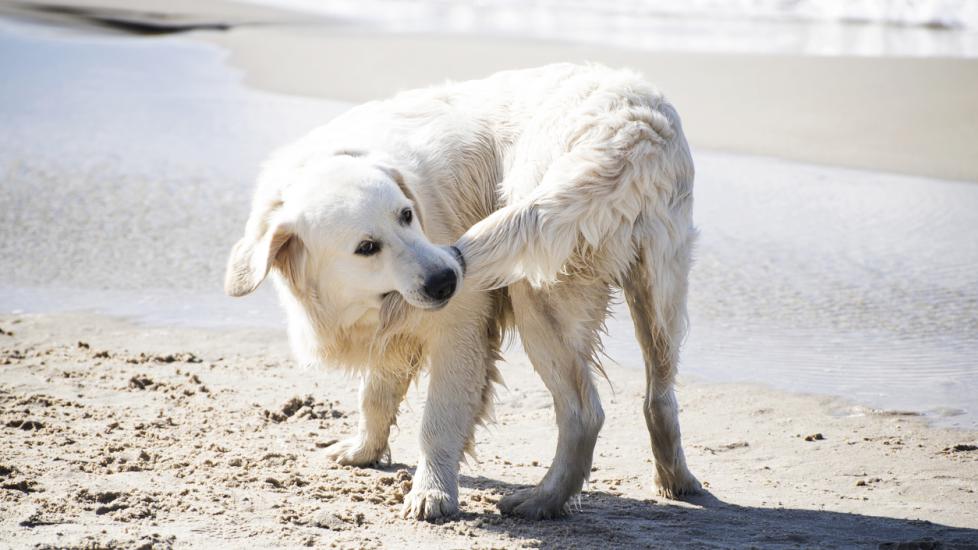Dogs, with their boundless energy and curious natures, often engage in a variety of behaviors that can leave us scratching our heads or laughing at their antics. One such behavior is tail chasing – an activity where dogs enthusiastically spin around after their own tails as if pursuing the ultimate prize. This seemingly amusing habit may have pet owners wondering what drives their furry friends to do this. In this article, we’ll delve into the reasons behind why dogs chase their tails and provide insights on how you can help your dog find more constructive ways to expend all that puppy power.
The Mysterious Tail Chasing Behavior Explained:
1. Playful Instincts: Many times, tail chasing is just another form of play for dogs. It’s a way for them to entertain themselves when they don’t have toys or other pets around. The movement of the tail becomes a fun object to chase, much like a cat might bat at its own paws.
2. Stimulation Seeking: Boredom can be a significant factor in tail chasing. If your dog isn’t getting enough mental stimulation or physical exercise, he may resort to self-entertainment by giving chase to his own tail. Providing plenty of interactive games, puzzles, and regular walks can reduce these types of repetitive behaviors.
3. Investigation Mode: Sometimes, dogs will chase their tails because something feels off—a flea bite, an itch from allergies, or even a foreign object caught between the toes. By following their tails closely, they are trying to understand what is causing the discomfort. Regular grooming sessions and veterinary checkups can help address any underlying issues.
4. Territoriality: A wagging tail can signal dominance or aggression in some breeds. When a dog chases its own tail in this context, it could be seen as part of establishing control over its environment. Positive reinforcement training techniques can redirect this behavior into appropriate channels.
5. Genetics and Herding Instincts: Certain breeds, particularly those bred for herding (like Border Collies), may exhibit tail chasing due to their instinct to round up animals or objects. This behavior can be redirected through activities that satisfy their natural inclinations, such as agility courses or fetching games.
6. Health Concerns: Occasionally, tail chasing can indicate neurological problems, skin conditions, or obsessive-compulsive disorders. If your dog persistently chases its tail without apparent cause and seems distressed, consult with a veterinarian immediately. Early intervention can lead to effective treatment options.
Managing Your Dog’s Tail Chasing Habit:
To manage tail chasing behavior effectively:
1. Provide Engagement: Keep your dog mentally stimulated with puzzle toys, new play experiences, and training sessions. Enroll him in obedience classes or involve him in canine sports to give him outlets for his instincts.
2. Regular Exercise: Daily walks and playtime ensure your dog gets ample opportunity to burn off excess energy. Physical exertion can significantly reduce instances of boredom-induced behaviors.
3. Environmental Enrichment: Make sure your home offers plenty of environmental enrichment opportunities, including perches, chew toys, and hiding places. This encourages natural behaviors and reduces stress.
4. Positive Reinforcement Training: Teach your dog alternative behaviors that can replace tail chasing, using positive reinforcement methods. Reward him whenever he performs a desired action, which strengthens the connection between good behavior and treats.
5. Consistent Routines: Establish clear rules and routines within your household. Consistency helps dogs feel secure and less likely to develop compulsive habits out of anxiety or confusion.
6. Veterinary Checkup: Regular health checks can identify any underlying medical causes for unusual behaviors. Treatment of these conditions can resolve the problem at its source.
Remember, every dog has its unique personality and motivations. Understanding your pet’s individual needs is crucial in managing unwanted behaviors. With patience, consistency, and creativity, you can transform tail chasing from a baffling quirk into a thing of the past!
